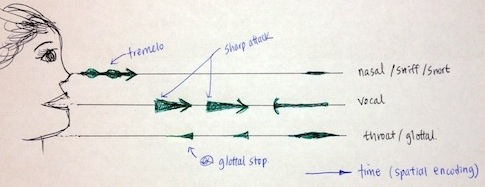This sketch conveys how to imitate a particular laugh instance:
The sound file used as an inspiration for this diagram is from Professor Wallace Chafe’s website: laughter sample (Note: some features, like the glottal stop, have been added to the sketch, but are not found in the audio).
Laughter includes not only sounds from the vocal tract, but also breathing noise, glottal stops, and occasionally even sniffs and snorts. This system is good for conveying how different components of laughter are produced by separating out the three major sources (approximately nose, mouth, throat).
Additionally, the notation distinguishes an inhale (left-pointing arrows) from an exhale (right-pointing arrows), and voiced (sharp arrow-head) from unvoiced (round arrow-head). The intensity envelope for each pulse unit is conveyed as the thickness of the arrow-body. This part of the design is re-used in my second transcription system, described in the next sub-section.
Unfortunately, it would be difficult to automatically generate this type of notation based on existing techniques, and it would require coming up with a machine learning algorithm for source separation as well as classification into the three possible sources. Moreover, the transcription as shown does not contain any pitch or spectral information beyond what can be inferred from the source.
